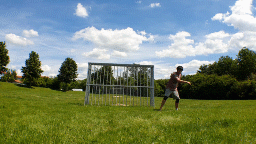Corkscrew
Optional
Back Fulltwist

The Corkscrew, or commonly referred to just Cork, is a Back Fulltwist that is swung into. A more simple way to think about it is a B-Twist that is executed from a Gainer setup. It is arguably one of the most, if not the most popular trick.
Two common ways to learn the Cork
Gainer Flash + Back Full
This is a very popular approach for this trick and many trickers that come from a tumbling or cheerleading background find this to be the easiest way to learn the Corkscrew. These Corks tend to me more inverted than others, which has its own advantages and disadvantages. They are great to progress into multiple rotations and can also be very useful to setup into a pop or swingthrough transition.
Slant Gainer + B-Twist
This is my preferred way of teaching this trick as it doesn’t require a textbook gainer nor a Fulltwist (which can be arguably just as hard as the cork). Your Gainer does not need to be perfectly inverted. It should at least be horizontal to the ground and flip over your shoulder. The B-Twist will be your prerequisite to learn twisting in general. Corks that are learned this way tend to be more on the horizontal plane. They can be harder to add multiple rotations to but they offer flexibility when it comes to single rotated variations. Examples: Slant Gainer + B-Twist Round = Cork Round. Slant Gainer + B-Twist Hyperhook = Boxcutter…
01 Slanted Gainer
Sometimes also referred to as “Cheat Gainer”. It’s basically a Gainer Flash that flips over your shoulder instead of over your head. You can also view this an Aerial that is swung into rather than a Flashkick. To learn the Cork you can even approach it as a Butterfly Kick that is swung into. That makes it even easier to progress into a Cork, because now it’s just a B-Twist that is swung into.
02 B-Twist
The Butterfly Twist will teach you how to twist in general. It is essentially the same trick as the cork but it utilities a frontswing instead of a backswing. If you were to perform a Butterfly Twist from a backswing it should turn into a Corkscrew. Make sure you are very comfortable with this trick before you attempt to try Corks, just to be safe.
03 Cork
Now all you need to do is piece those two tricks together. Pick your most comfortable setup that you use for your Gainer. For me it’s the Scoot. Swing up the same way as your Gainer and do not twist too early. Imagine trying to flip over a wall, which is shoulder high. As soon as your swinging leg reaches its peak, perform a B-Twist. It really is just that. Remember to use your shoulders and shrug them up to gain some more height and your arms to initiate the twisting momentum. If you cannot land it initially just drill the prerequisites until they become second nature. Your Cork progress will follow by itself.
Tips
There is also a very oldschool way of learning the Cork by adding a Butterfly Twist after a Round Kick. They only utilise the second half of the backswing and are also known as boneless Corks. It can be a fun variation to play around with as it offers a lot of flexibility for combos and transitions. Cartwheel_vanish_Corkscrew for example.
As soon as you initiate the twisting momentum, try to turn around fast and spot the floor early. This will make the landing more controlled and will make it easier to transition into the next trick.
If you are not inverting enough, you are twisting too early. You really need kick up first before you twist. Drill those gainers first and then apply the Twist to that.
If you can’t make it around all the way, stopping halfway kind of like an Arbabian, then you need to work on your twisting tricks. Drill B-Twists or Fulltwists more and get used to that feeling. Tricking is all about the prerequisites.




